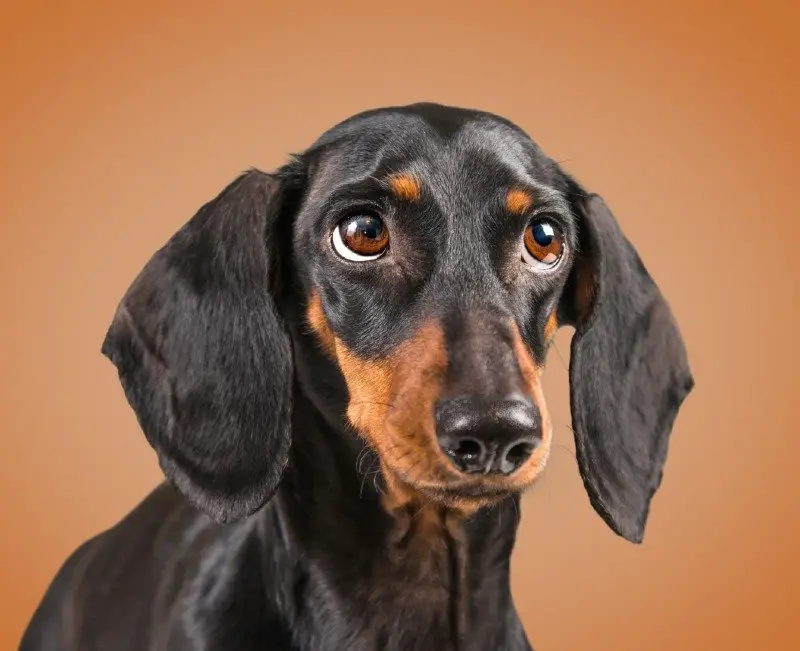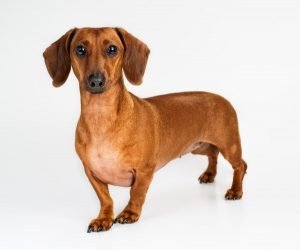
Dachshund Breed Profile
These small German hunting dogs are adored the world over for their endearing appearance and character to match.
- Companion Dog
- 12-15 Years
- Strong Will
Dachshund Profile
What's the Dachshund's history and background?
Dachshunds have remained a staple of UK life for decades and it’s easy to see why. Their diminutive stature and boisterous personality has won legions of fans since the breed found homes outside of its native Germany.
The name of the breed literally means “badger dog” in German, Dachs (badger) and Hund (hound). The pronunciation does vary in the UK, the most popular being “daks-hund”, however there are many affectionate nicknames for the breed, including the weiner-dog or sausage-dog due to their unmistakable long-backed oblong shape with little legs.
It is thought that ancestors of Dachshunds were initially bred from the Schweisshund breed crossed with the Bibarhund during 15th century Germany, however there are traits of other hounds and terriers in the family history of the Dachshund. The first mentions of the Dachshund breed are evident around the 18th century, when breeders began selecting the short leg trait, to create a dog ideal for flushing out smaller prey from their dens, such as badger. As time passed and selective breeding continued, the legs of some of the Dachshund variants were designed to be even smaller, with the aim of flushing out smaller prey such as rabbits. These variations from breeding have resulted in three distinct Dachshund variants being recognised. The first is the regular sized breed standard, there are then two types of miniature Dachshund, the regular miniature type and a dwarf Dachshund, often called a rabbit Dachshund.
There are three coat varieties of Dachshund breed, smooth, short coat, long-haired, and wiry coat. The smooth coat variation is by far the most popular, particularly in the UK, with long haired and wire-haired varieties only really appearing in native Germany. The most popular coat colourings of the Dachshund are red, and the two coloured black and tan coats in the UK, however a long list of additional colours are accepted as for breed standards such as black and cream, chocolate and tan/cream, and silver dapple and tan/cream.
What's the Dachshund's Behaviour & Personality like?
- Dachshund’s love to keep busy by exploring outdoor areas and have a surprising amount of energy and stamina for such a small dog.
- As with many smaller breeds, they are perfect companion dogs who love to cuddle up with their owners on the sofa, this loyalty is largely why they have become such popular companion dogs and thrive in a family home with children of any age.
- Dachshunds are known to be strong willed and intelligent, with a strong prey drive. For this reason they are not recommended for first time dog owners as training can be difficult for the inexperienced.
- Training needs to start early on for this breed, with commands that suit their high intelligence, however the strong prey drive can lure even the best behaved Dachshund.
How to groom a Dachshund
- How to groom your Dachshund will depend on what coast variation you have.
- The more common short-haired soft coat requires minimal care, a wipe with a towel or cloth is adequate after washing, which should be infrequent.
- Long-haired Dachshunds take a little more time and patience, with regular brushing recommended depending on the length of coat.
- The wire-haired Dachshund should also be brushed regularly to keep the coat healthy and clean with infrequent bathing. The thick undercoat of Dachshunds may need stripping twice a year.



How much exercise does a Dachshund need?
- Although small, the Dachshund is a hunting dog with large lungs and heart, meaning they thrive on daily exercise of at least 1 hour a day.
- Shorter walks are usually fine in the morning, however longer walks in the evening will be needed, that involve exploring the local environment and fulfilling the breed’s natural instinct to hunt prey by smelling and investigating burrows and mounds.
- Too little exercise can cause Dachshund’s to develop unwanted, destructive behaviours and barking.
- Back gardens are perfect places for the breed to explore and express themselves, however, be mindful of any gap in fences or small holes, as the Dachshund is an expert burrower.
How much training does a Dachshund need?
- Training needs to start early on for this breed, with commands that suit their high intelligence, however the strong prey drive can lure even the best behaved Dachshund.
What are common health issues for a Dachshund?
- Due to their unique and unbalanced frame, the Dachshund unfortunately suffers from many health ailments and conditions, which is something to bear in mind if you are looking to bring one into your home.
- Spinal problems can plague this breed so ensure they maintain a healthy weight to stave off any unwanted disc damage. Intervertebral disk disease (VDD) is common in Dachshunds, largely due to their extremely long spinal column but short rib cage.
- Patellar luxation is also an issue with Dachshunds due to their short legs needing to support the large body. This condition can cause the patella (knee bone) to become dislodged, causing pain for the dog.
- Wire-haired variations are prone to carrying brittle bone disease, also called osteogenesis imperfecta. Around 17% of wire-haired breeds carry this genetic disorder.
- Epilepsy can be present in Dachshunds, causing seizures caused by electric storms in the dogs brain.
- As with all breed types, it’s best to get your Dachshund from a responsible breeder, and make use of DNA testing for some of the common health ailments.

